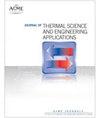Numerical Investigation of Nanofluid as a Coolant in a Prismatic Battery for Thermal Management Systems
IF 1.4
4区 工程技术
Q3 ENGINEERING, MECHANICAL
引用次数: 0
Abstract
This study delves into the realm of numerical investigation of the heat transfer performance of nanofluids as coolants for prismatic batteries. Nanofluids are being employed in battery cooling systems to enhance overall thermal management and ensure the safe operation of batteries, particularly in situations involving high heat generation. In this study, different types of nanofluids were used along with a base fluid of ethylene glycol-water (EG-water 50%). The energy equations consider the effects of viscous dissipation and heat generation. The model generates a set of nonlinear partial differential equations (PDEs), which can be transformed into ordinary differential equations (ODEs) using appropriate similarity variables. These ODEs are then solved numerically by employing the Range-Kutta-Fehlberg method along with the shooting method to obtain solutions. The simulations in both 2D and 3D showcase the results for various parameters pertaining to thermal and velocity fields, heat transfer rate, and drag force. The findings reveal that heat generation leads to a staggering increase in temperature of 78.22%. However, using aluminum nanoparticles as opposed to copper nanoparticles quickly reduced the battery's maximum temperature by 9.31%. The exceptional heat generation strengths of CuO-EG and Al2O3-EG nanofluids also resulted in a significant increase in their heat transfer rates of around 40.42% and 42.13%, respectively. Additionally, the aluminum NPs exhibited a more rapid heat transfer rate of 4.06% when compared to the copper nanoparticles.将纳米流体作为棱柱电池冷却剂用于热管理系统的数值研究
本文对纳米流体作为柱形电池冷却剂的传热性能进行了数值研究。纳米流体被用于电池冷却系统,以加强整体热管理并确保电池的安全运行,特别是在涉及高热量产生的情况下。在这项研究中,不同类型的纳米流体与乙二醇-水(eg -水50%)的基础液一起使用。能量方程考虑了粘性耗散和热产生的影响。该模型生成一组非线性偏微分方程(PDEs),并利用适当的相似度变量将其转化为常微分方程(ODEs)。然后采用Range-Kutta-Fehlberg法和射击法对这些偏微分方程进行数值求解。2D和3D的模拟展示了与热和速度场、传热率和阻力有关的各种参数的结果。研究结果表明,热量的产生导致了温度的惊人上升78.22%。然而,与使用铜纳米颗粒相比,使用铝纳米颗粒可迅速将电池的最高温度降低9.31%。CuO-EG和Al2O3-EG纳米流体的产热强度也显著提高了换热率,分别达到40.42%和42.13%左右。此外,与铜纳米粒子相比,铝纳米粒子的传热速率更快,达到4.06%。
本文章由计算机程序翻译,如有差异,请以英文原文为准。
求助全文
约1分钟内获得全文
求助全文
来源期刊

Journal of Thermal Science and Engineering Applications
THERMODYNAMICSENGINEERING, MECHANICAL -ENGINEERING, MECHANICAL
CiteScore
3.60
自引率
9.50%
发文量
120
期刊介绍:
Applications in: Aerospace systems; Gas turbines; Biotechnology; Defense systems; Electronic and photonic equipment; Energy systems; Manufacturing; Refrigeration and air conditioning; Homeland security systems; Micro- and nanoscale devices; Petrochemical processing; Medical systems; Energy efficiency; Sustainability; Solar systems; Combustion systems
 求助内容:
求助内容: 应助结果提醒方式:
应助结果提醒方式:


